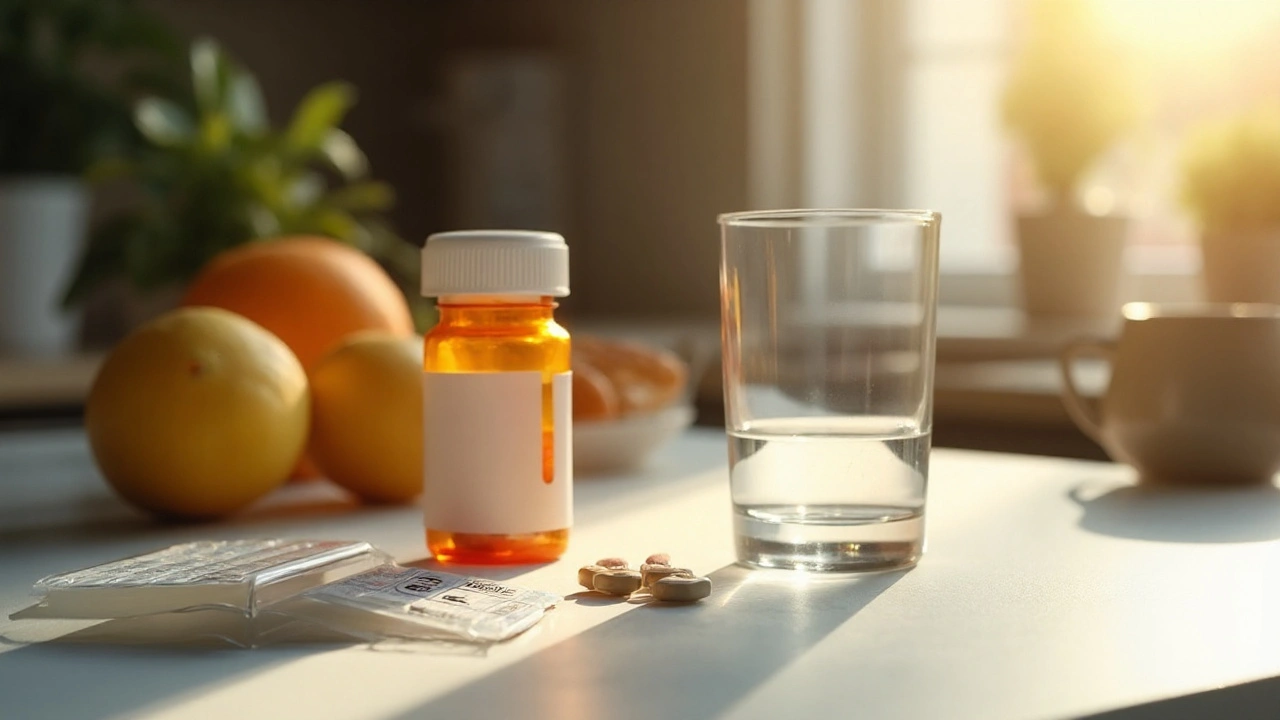TL;DR
- Allopurinol lowers uric acid to prevent gout attacks and kidney stones.
- Start with a low dose (100mg daily) and increase gradually to 300‑600mg as needed.
- Take it after meals with a full glass of water to reduce stomach upset.
- Common side effects: rash, nausea, and liver enzyme changes; serious reactions are rare but require immediate medical attention.
- Never stop abruptly; taper under doctor supervision to avoid rebound spikes in uric acid.
What Is Allopurinol and When Is It Used?
Allopurinol is a pill that blocks the enzyme xanthine oxidase, the main culprit turning purines into uric acid. When uric acid builds up, it can crystalise in joints and cause the painful, swollen attacks people know as gout. It’s also prescribed to reduce uric acid in people with kidney stones or tumour lysis syndrome after chemotherapy.
Doctors don’t give allopurinol to treat an acute gout flare; it works best as a long‑term preventive measure. If you’re still dealing with a flare, your doc will likely send you a short‑term anti‑inflammatory drug first, then add allopurinol once the joint settles.
How Allopurinol Works in the Body
The drug binds to xanthine oxidase, stopping it from converting hypoxanthine and xanthine into uric acid. With less uric acid produced, blood levels drop, and the body can clear the excess through the kidneys. Over weeks, the crystal deposits shrink, and the frequency of attacks drops dramatically.
Because it acts on the production side rather than the excretion side, allopurinol works even if kidney function is modestly reduced. That’s why it’s a go‑to for many chronic gout patients.
Typical allopurinol dosage & Administration Guidelines
Dosage isn’t one‑size‑fits‑all. Your doctor will base it on your uric‑acid level, kidney function, and how you tolerate the medication. Below is a quick snapshot of common dosing regimens.
| Condition | Starting Dose | Typical Target Dose | Maximum Dose |
|---|---|---|---|
| Gout (primary prevention) | 100mg once daily | 300‑600mg/day split into 1‑2 doses | 800mg/day (rarely needed) |
| Hyperuricemia with kidney stones | 100mg daily | 200‑400mg/day | 600mg/day |
| tumour‑lysis syndrome prophylaxis | 200mg twice daily | 600‑1,200mg/day, adjusted for renal function | 1,200mg/day |
Key tips for taking the pill:
- Start low, go slow. Most people begin at 100mg and increase by 100mg every 2‑4 weeks.
- Take it after meals. Food helps minimise stomach irritation.
- Stay hydrated. A full glass of water each dose helps the kidneys flush out what’s left.
- Don’t skip doses. Missing days can cause uric‑acid spikes that trigger a flare.
- If you have kidney impairment, your doctor will cap the dose (often 300mg) and monitor blood work closely.

Common Side Effects and What to Watch For
Most folks tolerate allopurinol well, but the drug does have a side‑effect profile worth knowing.
- Rash: A mild skin irritation is common, but a widespread, blistering rash could mean Stevens‑Johnson syndrome - a medical emergency.
- Nausea or upset stomach - usually eases when you take the tablet with food.
- Changes in liver enzymes - your doctor will order blood tests after the first few months.
- Rare: bone‑marrow suppression leading to low blood counts. Seek medical help if you feel unusually fatigued, bruised, or develop infections.
If any of these symptoms feel severe or come on suddenly, call your doctor right away. Stop the pill only after a professional tells you it’s safe.
Practical Tips & Frequently Asked Questions
Here are the little details that often trip people up.
- Can I drink alcohol? Moderation is key. Alcohol raises uric acid, so heavy drinking can undo the benefits of allopurinol.
- Do I need regular blood tests? Yes. Your doctor will check uric‑acid levels, kidney function, and liver enzymes every 2‑3 months initially, then less often once stable.
- What about pregnancy? Allopurinol is generally avoided unless the benefits outweigh the risks. Discuss alternatives with your obstetrician.
- Can I switch to febuxostat? Febuxostat works similarly but is more expensive and has its own safety warnings. A switch should be doctor‑driven.
- Why did my gout flare after starting allopurinol? The first few weeks can see a temporary rise in uric‑acid crystals as the body readjusts. Doctors usually prescribe colchicine or NSAIDs during this “start‑up” phase.
In short, treat allopurinol as a long‑run commitment. Pair it with lifestyle tweaks - low‑purine diet, weight control, and limited alcohol - and you’ll see fewer attacks and smoother joints.
Next Steps & Troubleshooting
If you’re starting allopurinol, set up an appointment with your GP to get a baseline uric‑acid test and a kidney‑function panel. Keep a simple log of any side effects; that makes follow‑up visits easier.
Feel a rash? Stop the medication and call your doctor right away - don’t wait to see if it fades.
Missed a dose? Take it as soon as you remember, unless it’s almost time for the next one. In that case, skip the missed pill and resume the regular schedule.
Still having frequent flares despite a stable dose? Your doctor might need to adjust the amount, add a short‑term anti‑inflammatory, or check for other triggers like high‑purine foods.
Remember, the goal isn’t just to lower numbers on a lab report; it’s to keep you moving comfortably through everyday life.


Krishna Kranthi
September 21, 2025 AT 21:41Allopurinol’s like that one friend who shows up late to the party but ends up fixing everything - slow to start, but once it’s in motion, the vibe changes. I’ve been on it for three years now, kidney stones gone, gout flares down to once a year, max. Took me six months to find the sweet spot - 200mg at night, with a liter of water before bed. No alcohol, no red meat after 6pm, and I swear by tart cherry juice. Not magic, just consistency. Also, don’t ignore the rash. I saw a dude ignore it, ended up in ICU. Don’t be that guy.
Jessica Glass
September 22, 2025 AT 01:57Of course the article doesn’t mention that allopurinol was originally developed as a chemotherapy drug. Funny how Big Pharma repackages poison as ‘preventative care’ while you’re still paying $12 for a 30-day supply. Meanwhile, your doctor’s too busy scrolling through their iPhone to ask if you’ve ever heard of ‘diet’.
John Bob
September 22, 2025 AT 09:22There’s zero evidence that allopurinol prevents gout long-term. It just masks symptoms while the underlying metabolic dysfunction worsens. The real solution? Fasting. Intermittent fasting. Your body clears uric acid naturally when it’s not constantly flooded with processed carbs and fructose. But no, let’s just keep popping pills like they’re M&Ms.
Lilly Dillon
September 23, 2025 AT 00:27I started allopurinol last year after my third gout attack in six months. First month? Flare-ups like crazy. Thought I was doomed. Then my doc added colchicine for a month and everything clicked. Now I feel like a new person. No more limping to the fridge at 3am. Still take it daily. Still drink water like it’s my job. Still avoid beer like it’s radioactive. Worth it.
Wendy Stanford
September 23, 2025 AT 09:04It’s fascinating how we’ve reduced a deeply biological, systemic issue - purine metabolism, mitochondrial stress, chronic inflammation - to a single pill you take after dinner. We’ve outsourced our responsibility to a molecule, as if the body is just a broken machine that needs a firmware update. We don’t ask why the purines are flooding the system in the first place. We don’t interrogate the diet, the stress, the sleep deprivation, the silent metabolic rot that precedes the crystal formation. We just swallow the pill and pretend the problem was always external. But the crystals? They’re not in the joints because of genetics. They’re there because we stopped listening to our bodies. And now we’ve built a whole industry around pretending we didn’t notice the warning signs until it was too late.
Alex Grizzell
September 23, 2025 AT 21:57Just wanted to say - you’re doing great. Seriously. If you’re reading this and you’re on allopurinol, you’re already ahead of 90% of people who ignore their gout until they can’t walk. Keep hydrating. Keep tracking. Keep showing up. You got this. 💪
Gavin McMurdo
September 24, 2025 AT 20:07Let’s be real: the FDA approved allopurinol in 1966. Since then, gout prevalence has doubled. Coincidence? Or is this just another case of treating the symptom while the disease - capitalism, processed food, sedentary lifestyles - thrives? They sell you a pill, you pay for it monthly, they profit, you stay sick. It’s not medicine. It’s a subscription model for chronic suffering.
Shiv Sivaguru
September 24, 2025 AT 20:46I took this for two weeks, got a rash, stopped. Doctor said ‘oh it’s fine’ then gave me another script. I’m not an idiot. I know when something’s not right. Also why does everyone ignore that 10% of people get life-threatening reactions? You think your ‘mild rash’ is just ‘side effect’? Nah. It’s your body screaming. Listen to it. Or don’t. I’m not your dad.
Jesse Weinberger
September 25, 2025 AT 03:15Allopurinol? More like allopurine-oh-no-what-have-i-done. I’ve been on it since 2020. Now my liver enzymes are up, my kidneys are ‘mildly impaired’, and I’m told to ‘take it easy’. Easy for you to say. I can’t even eat a burger without a flare. They didn’t warn me about the fatigue. Or the brain fog. Or how I now avoid mirrors because I look like a ghost who forgot to die. I’m not mad. I’m just… disappointed.
Emilie Bronsard
September 25, 2025 AT 07:07Thanks for the clear info. I’ve been on it 8 months and it’s been life-changing. Just wanted to add - if you’re nervous about starting, talk to someone who’s been on it longer. I found a Reddit group that helped me a lot.
George Johnson
September 25, 2025 AT 18:01So you take this pill to avoid gout… but you still eat steak every Sunday? That’s like putting a bandaid on a bullet wound and calling it progress
Rodrigo Ferguson
September 26, 2025 AT 15:37One must interrogate the epistemological foundations of pharmaceutical interventionism. The pharmacological suppression of uric acid production, while statistically efficacious in controlled trials, fails to account for the phenomenological lived experience of metabolic disharmony. One is not merely treating a biochemical anomaly; one is mediating a systemic rupture between organism and environment - a rupture exacerbated by the commodification of health under late-stage capitalism. Allopurinol, then, is not a cure, but a palliative for the symptoms of a civilization in metabolic collapse.